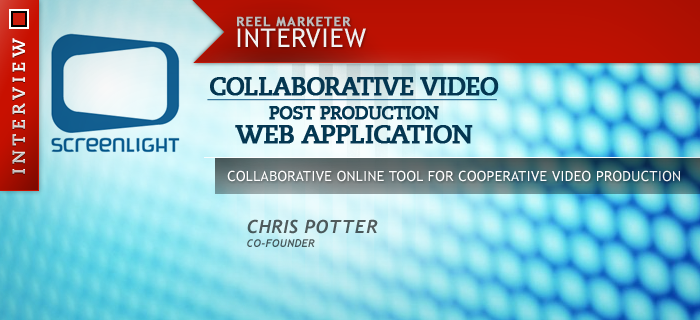Thanks for joining us in our interview series! Tell us about yourself and the company you're representing.
CHRIS POTTER / SCREENLIGHT: Thanks for taking the time to speak with me about what we do. I’m one of the founders of ScreenLight, a web application that provides a simple, private and centralized way to collaborate on video production.
Editors, production companies, and creative agencies use our service to upload videos they are creating, securely share them with teams and clients, and collect feedback right in the video timeline.
In short, ScreenLight improves project communication and it helps creative teams get projects approved faster!
Tell us more – what industries use ScreenLight? What are a few real-world scenarios where ScreenLight is being used?
SCREENLIGHT: Creative agencies, production companies, post-production companies, as well as, marketing, public relations, and HR departments at large companies and universities use our service.
- Video review and approval. This is the most common use of ScreenLight, and the one for which it was originally designed. In this scenario, a production company will create a project, upload some videos, and invite clients and colleagues to review them. Viewers can add comments alongside each of the videos, and they can include time codes in comments that link to specific video frames. Presenting feedback in the context of the videos helps improve communication.
- Television production. Clients are using ScreenLight for the different phases of TV production. After a shoot, dailies will be uploaded for review by the production team. Once the producer and editor select the shots they want to use, a rough cut of an episode will be prepared and uploaded to the system for review. Additional versions of the episode will be created and uploaded to ScreenLight until there is a final version that is approved by a broadcaster.
- Digital screeners for documentaries and movies. Some clients are using ScreenLight to share material with journalists, film festivals, and other reviewers before the films are publicly released. In this scenario, they are looking for a password protected way to share their work online. This replaces the tedious and insecure process of mailing out DVD screeners.
- Sharing video with financiers. Stakeholders in film and television projects often extend beyond the immediate production team. Production companies are using ScreenLight to keep financiers in the loop about progress of projects they have funded.
- Sales presentations and pitches. Agencies use ScreenLight to privately share pitch reels of their most relevant work with prospective clients. In a similar manner, sales organizations at large companies use ScreenLight to privately share videos that contain sensitive material that they don’t want to disclose on public video sites like YouTube.
- Corporate training and education. Large companies are using ScreenLight to host sensitive information like internal training and education videos. In these cases, our clients benefit from the fact that users must login with a username and password in order to view videos.
What is the experience as a creator using the ScreenLight interface?
Chris Potter: Our core mission is to help people create video more efficiently and get better feedback from their teams. The faster they can send something out for review, the faster they can move on to the next stage of the production. To this end, we have designed a simple user experience that is closely tailored to the workflow of video creators. The focus is on helping them get things done rather than overwhelming them with choices.
The workflow is designed around projects.
A project can be anything from a single video, to a television episode, and people can upload as many videos as they want to the project. Users can upload virtually any video format and we will automatically encode it so that videos will reliably play back on different web browsers, smart phones, and tablets.
There are two benefits to this.
[embedit snippet=”ad1″]The first is that video producers don’t have to waste time worrying about codecs and cross-browser compatibility. They can focus their attention on telling great stories. The second is that support for viewing on mobile phones and tablets means that the review process isn’t confined to the office.Project access is by invitation only. Administrators can add as many people as they want to a project, and they can set what each person can do on a project. They may want some users to just view videos, while other users may have permission to comment on videos, and others may have permission to upload or download videos.
Administrators may also choose to share the project with a private link that contains an access token.
Anybody with the private link can then click it and login directly to the project without having to enter a password.
The hub of each project is the Screening Room where project participants can view and comment on the videos. Navigation of videos is quick and simple, as we automatically create a video playlist. Viewers can add time codes to their comments so that feedback is precise and meaningful. The timeline displays markers where there are comments, so it’s easy to see and navigate to points in the video that need to be changed.
What is the process like for someone that is reviewing videos?
Chris Potter: One of the core principles in designing ScreenLight was to keep the experience as simple as possible for the reviewer.
People that are asked to collaborate on a project or provide feedback on some videos don’t have time to spend learning a complex interface. They want to log in to the application, provide their feedback and get on with the 1000 other things that they have to do in a day.
When reviewers login, the see a list of projects they have access to. Clicking through to one of the projects brings them to the Screening Room with a large video player where they can view and provide feedback on videos.
For these users the experience is as simple as viewing a video in YouTube.
What issues does ScreenLight solve that previously existed?
Chris Potter: During production, videos are typically shared using a combination of courier, email, FTP, Dropbox, or YouTube / Vimeo. We solve the three major problems with existing solutions:
- It's difficult to transfer video files. Sending hard drives and DVDs by courier is slow and expensive. Email doesn’t work due to the large file sizes. FTP is cumbersome to administer securely and is confusing to clients. Consumer video sites like YouTube don’t provide a secure and professional user experience.
- It’s difficult to ensure playback compatibility. Alternatives like FTP and Dropbox allow you to transfer large files. However, these tools simply transfer videos. They do not auto-matically encode video so that it will playback on phones and tablets. It’s up to the person sharing video to make sure that it’s available in the formats that their collaborators can view. Encoding into different formats is time consuming and challenging to stay on top of. With ScreenLight, you just turn things over to us and we take care of the complexity of encoding video so that they can be played back anywhere.
- Feedback is separated from the videos. In all of the alternative solutions feedback is separated from the videos. This means that the conversation gets fragmented across phone conversations, review meetings, and email threads. This creates potential for miscommunication, and it wastes time, as someone has to sift through the various conversations and put together a prioritized list of what needs to be done next to move the project on to the next step. With ScreenLight, communication is kept in the context of each video. Time coded comments ensure that feedback is precise and meaningful.
With ScreenLight we make it easy for project participants to easily navigate a review process that can otherwise be confusing, frustrating, or intimidating.
What would you say to someone who thinks they’re happy with using ‘private’ YouTube videos to share projects? What are the limitations/dangers of this ‘free’ option?
Chris Potter: There are several downsides with using YouTube’s free service for privately sharing videos.
YouTube videos are posted publicly by default. If you are using the service to host private videos for your clients, then the onus is on you to assure them that nobody else will be able to see the videos. For some clients this may be O.K., but for those with strict IT policies, YouTube may not be an acceptable option. With ScreenLight, all projects are private by default and all data transfer between the viewer and our servers is encrypted. All access is password protected, so people will only see videos if you grant them permission.
With YouTube, you give up control over your brand, and for video professionals, this isn’t something that should be taken lightly. For example, advertisements may be overlaid on your videos, and the viewer will be presented with a list of related videos on the side of the screen. Sometimes these related videos can be inappropriate or even offensive to your client.
By contrast, ScreenLight is advertising free and we allow you to brand the application with your own logo and corporate colors, so that you present the best image possible.
YouTube doesn’t provide an easy way to streamline conversations about project videos. Reviewers can’t easily make comments at specific frames of the video. As a result, people will either email their feedback to producers, or enter long comments that describe where changes need to be made.
The bottom line is that ScreenLight is purpose designed for collaborating with others on video production. Using a tool that is specifically geared for this workflow saves time and creates a better experience for you, for your team, and for your clients.
Is it possible to calculate the return on investment (ROI) of using this tool for agencies doing video production?
Chris Potter: While the ROI is going to be different for each client due to their particular workflow, software, salaries, and client relationships, there are several sources of return from using ScreenLight.
For companies that are sending hard drives or DVDs back and forth via courier, there are obvious direct savings associated with sending packages.
On top of this, using ScreenLight saves time spent preparing courier packages, as well as, time spent waiting while material is in transit. Nobody is providing feedback while a package is travelling from Toronto to LA, and this means that production timelines drag on longer than they need to.
In the case of companies using FTP or an in-house system, there are savings to be had in terms of IT administration. ScreenLight is a software as a service application, so it’s always up to date and it doesn’t need someone to apply security patches or add new users. Customers also receive the benefit of frequent feature updates without having to install application updates.
There are benefits of saving time on projects.
Time saving is the hardest metric to quantify, but it’s also where the most significant savings can come from. Your staff doesn’t have to waste time encoding videos into different formats for review, they don’t have to troubleshoot playback issues, and they don’t have to spend time chasing down feedback from collaborators.
Your staff no longer has to waste time sifting through long email chains and meeting notes to figure out what needs to be done to move the project forward. Centralizing feedback in one place helps reduce miscommunication and saves people time associated with doing unnecessary rework on the project.
We have seen many companies asking themselves “could video collaboration be the answer for our project pains”? A faster and more efficient video review process helps clients and their collaborators save time and money.
What are the top 5-10 tips you have for a company distributing video on the web?
Chris Potter: Let me list out six top ways we have seen work for our clients!
- Decide where you want your videos to appear. Do you want to simply display videos on your site, or do you want to take advantage of the audiences that platforms like YouTube and Vimeo bring to the table. An answer to this question will help you decide what platform to use.
- Define what success of your campaign looks like and how you will measure this. If you need basic stats and an aggregate view of your video performance, then YouTube or Vimeo may provide all the answers you need. If you want very detailed stats like how long each person has viewed a video, or real-time analytics, then one of the commercial platforms may be the right fit.
- Decide if you need custom calls to action. If you just want to play videos back on your site then YouTube and Vimeo should work. If you want to add a custom link at the end of the video that has a clickable call to action, or if you want someone to enter an email address before they can playback a video (good for lead generation) then you may need to look at a paid alternative.
- Determine your branding requirements. Is it acceptable if your videos have advertisements overlaid or links to other recommended videos? If so, YouTube and Vimeo are great. If not, a commercial alternative might be best. Likewise, if you would like a custom video player or a high-degree of control over the look of the player, hosting videos yourself or using a commercial service might make the most sense.
- Make sure that your content is allowed by the terms of service of the service you upload it to. It is against the terms of service to use Vimeo for commercial services unless you are a Vimeo Pro user ($199 / year). YouTube is much more permissive of commercial activity, so it can be a good option for promoting your business.
- Use presets for encoding if possible. Most encoding software provides presets for YouTube or Vimeo and these should also work well for most other online video platforms. Most videos services will encode your video into a couple of different sizes and bitrates for broad playback compatibility. With these services, your task is to upload a high-quality source file. The higher the quality of input file you provide, the higher the quality of the output files. If you are hosting videos yourself, I would create a 1280 x 720 video at approximately 1,500 Kbps and a 480 x 320 video at a bitrate of 750 Kbps. For a given frame size, the bitrate is going to be the biggest determinant of quality, so you will want to adjust the bitrate or quality settings based on the type of video you are distributing. Video without a lot of motion like a screencast or talking heads can playback fine at lower bitrates, while videos with lots of motion will need higher bitrates for acceptable playback quality.
Where is online video advertising headed in the future?
Chris Potter: In time, I think virtually all businesses that maintain an online presence will use online video in one form or another.
While some people will find success with pre-roll/post-roll/overlay and other forms of paid advertising, I think most will find success with video that is embed on their own sites, their YouTube / Vimeo channels, and other social mediums.
Take a look at startups for one example of where online video advertising is going. It has almost become essential to create explainer videos that bring their product and the problem they are solving to life. Video helps create an emotional connection that’s very difficult to do with words on a page. Dollarshave is an example of a startup that did an amazing explainer video, turning a $4,500 investment into thousands of customers and millions of dollars worth of press.
An article about B2B Video Marketing Best Practices and Tips from Cisco had some good examples of how video can be used at different stages of the sales process. It also had a couple of stats that highlight the importance of B2B video, “96 percent of IT decision makers and tech buyers watch videos for business. Even more impressive are high share-through rates: a whopping 84 percent either forward, share, or post tech-related videos”.
As another example, ecommerce retailers are just at the starting phase of using video to bring products to life and reduce the friction of buying products like shoes and fashions online. Zappos is doing this really well. It has a comprehensive video strategy and is doing short videos of all the different shoes that it carries. The result of its strategy is rapidly growing sales, fewer returns, and increased customer satisfaction.
[embedit snippet=”ad2″]Finally, online video presents big brands with new ways to engage with their target audience through branded entertainment. Here I’m not talking about just inserting a Tide box into a TV show like in the 50’s. I’m talking about things like Red Bull’s sponsorship of Felix Baumgartner’s freefall from the stratosphere.While this event is an extreme example, with 8 million simultaneous viewers on YouTube and record viewership for the live broadcast on Discovery Network, it’s clear that when done well, branded content can far eclipse the awareness and engagement of traditional advertising campaigns.
In all of these online campaigns, the key to success is in understanding your target audience, clearly defining your own objectives, and creating the most engaging stories possible. Remember, video content doesn’t need to be viral, it just has to connect with your target audience.
Glad to have you on Chris, and that we’re finally able to get ScreenLight featured as part of the Reel Designer interview series! What are the best way for someone to get started with ScreenLight to see if your services are a fit?
Chris Potter: The easiest way to find out more about our service is to check out our site at http://www.screenlight.tv. You can also chat with us on Twitter, email us at info@screenlight.tv, or give us a call at 1.800.940.6021. We love speaking with people about their workflow and problems they have sharing video! Thanks again!





